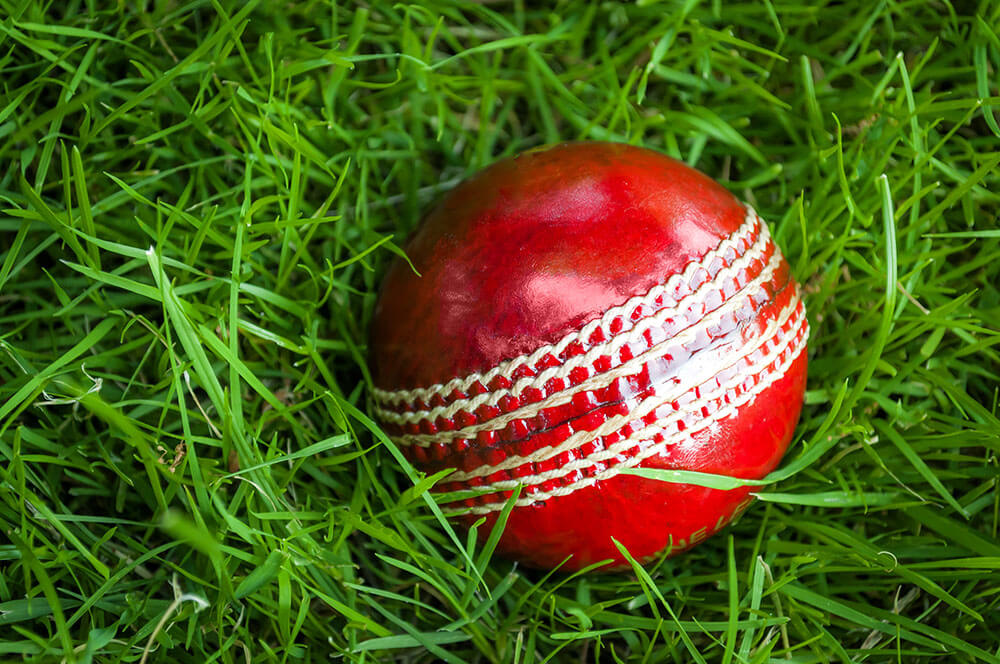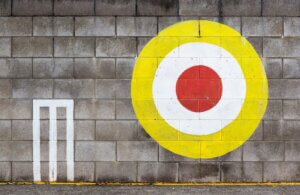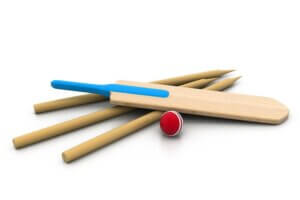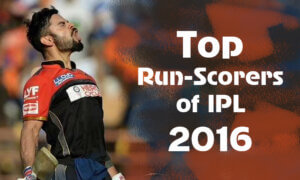What Is the Weight of a Cricket Ball?

In this article, we are going to review various rules as per the Laws of cricket that are related to balls used in cricket, including the weight and size of balls used in men’s, women’s and youth cricket, the standard that defines materials and specifications as well as rules defining the rights of umpires and players concerning the use of cricket balls in matches.
Contents
Cricket Ball: Weight and Size
According to the Laws of Cricket published by the Marylebone Cricket Club, the custodian of the Laws since its formation in 1787, the weight and size of a ball used in men’s cricket must adhere to defined specifications.
Contents
A new ball considered for use in a men’s cricket match must weigh at least 5 1/2 ounces or 155.9 grams. The weight of the ball must not exceed 5 3/4 ounces or 163 grams. The circumference of the ball must be at least 8 13/16 inches or 22.4 centimetres. The circumference must not exceed 9 inches or 22.9 centimetres.
Men’s, WMen’s, Women’s and Youth Cricket Balls
ht and dimensions of a ball used in a men’s cricket match have already been specified. Do the dimensions differ for a ball used in a women’s or children’s game? The answer is “Yes.”
Weight and Dimensions ofWeight and Dimensions of a Ball in Women’s Cricket
ric-life.com/article/why-are-pink-balls-used-in-day-night-test-matches/" target="_blank" rel="noopener noreferrer">new ball considered for use in a women’s cricket match must weigh at least 4 15/16 ounces or 140 grams. The weight of the ball must not exceed 5 5/16 ounces or 151 grams. The circumference of the ball must be at least 8 1/4 inches or 21.0 centimetres. The circumference must not exceed 8 7/8 inches or 22.5 centimetres.
Weight and Dimensions of aWeight and Dimensions of a Ball in Youth Cricket
use in a junior (U-13) cricket match must weigh at least 4 11/16 ounces or 133 grams. The weight of the ball must not exceed 5 1/16 ounces or 144 grams. The circumference of the ball must be at least 8 1/6 inches or 20.5 centimetres. The circumference must not exceed 8 11/16 inches or 22.0 centimetres.
Materials and SpecificatioMaterials and Specifications
for the manufacture of a cricket ball must adhere to the British Standard BS 5993 related to the construction and dimensions of a cricket ball. The quality and performance of such ball must also adhere to the said standard. Leather, string and cork are three distinct materials used to make a cricket ball. The ball usually has a core made of cork. The core is reinforced by wrapping string, several times, tightly around it. Leather is then used to encase the cork and string. Such leather may be dyed white (for balls used in T20 or one-day matches) or red (for use in Test and first-class matches). The level of the game to be played will determine whether the leather casing will consist of two or four pieces. Imagine you have quartered an orange. What shape does the peel have? Each piece of leather casing will resemble such peel. (The ball to be used in a top-quality game will involve the use of four pieces of the leather casing; two-piece balls are generally used for practice or lower-level games.) A series of stitched seams with the central seam slightly raised will be used to join two leather hemispheres. The seam will be akin to an equator. Typically, the “equator” is marked by six rows of stitches.
Rules for Cricket Balls
<Rules for Cricket Balls
ricket specify the rules related to the ball used in a match. Law 5 includes 5 rules. Rule 1 of the law defines the weight and dimension of the ball (mentioned earlier in this article).
Weight and Dimensions of a Ball in Women’s Cricket
ric-life.com/article/why-are-pink-balls-used-in-day-night-test-matches/" target="_blank" rel="noopener noreferrer">new ball considered for use in a women’s cricket match must weigh at least 4 15/16 ounces or 140 grams. The weight of the ball must not exceed 5 5/16 ounces or 151 grams. The circumference of the ball must be at least 8 1/4 inches or 21.0 centimetres. The circumference must not exceed 8 7/8 inches or 22.5 centimetres.Weight and Dimensions of aWeight and Dimensions of a Ball in Youth Cricket
use in a junior (U-13) cricket match must weigh at least 4 11/16 ounces or 133 grams. The weight of the ball must not exceed 5 1/16 ounces or 144 grams. The circumference of the ball must be at least 8 1/6 inches or 20.5 centimetres. The circumference must not exceed 8 11/16 inches or 22.0 centimetres.
Materials and SpecificatioMaterials and Specifications
for the manufacture of a cricket ball must adhere to the British Standard BS 5993 related to the construction and dimensions of a cricket ball. The quality and performance of such ball must also adhere to the said standard. Leather, string and cork are three distinct materials used to make a cricket ball. The ball usually has a core made of cork. The core is reinforced by wrapping string, several times, tightly around it. Leather is then used to encase the cork and string. Such leather may be dyed white (for balls used in T20 or one-day matches) or red (for use in Test and first-class matches). The level of the game to be played will determine whether the leather casing will consist of two or four pieces. Imagine you have quartered an orange. What shape does the peel have? Each piece of leather casing will resemble such peel. (The ball to be used in a top-quality game will involve the use of four pieces of the leather casing; two-piece balls are generally used for practice or lower-level games.) A series of stitched seams with the central seam slightly raised will be used to join two leather hemispheres. The seam will be akin to an equator. Typically, the “equator” is marked by six rows of stitches.
Rules for Cricket Balls
<Rules for Cricket Balls
ricket specify the rules related to the ball used in a match. Law 5 includes 5 rules. Rule 1 of the law defines the weight and dimension of the ball (mentioned earlier in this article).
Materials and Specifications
for the manufacture of a cricket ball must adhere to the British Standard BS 5993 related to the construction and dimensions of a cricket ball. The quality and performance of such ball must also adhere to the said standard. Leather, string and cork are three distinct materials used to make a cricket ball. The ball usually has a core made of cork. The core is reinforced by wrapping string, several times, tightly around it. Leather is then used to encase the cork and string. Such leather may be dyed white (for balls used in T20 or one-day matches) or red (for use in Test and first-class matches). The level of the game to be played will determine whether the leather casing will consist of two or four pieces. Imagine you have quartered an orange. What shape does the peel have? Each piece of leather casing will resemble such peel. (The ball to be used in a top-quality game will involve the use of four pieces of the leather casing; two-piece balls are generally used for practice or lower-level games.) A series of stitched seams with the central seam slightly raised will be used to join two leather hemispheres. The seam will be akin to an equator. Typically, the “equator” is marked by six rows of stitches.Rules for Cricket Balls
<Rules for Cricket Balls
ricket specify the rules related to the ball used in a match. Law 5 includes 5 rules. Rule 1 of the law defines the weight and dimension of the ball (mentioned earlier in this article).Rule 2 of Law 5 has two parts, the first of which states that the captains and umpires must approve any ball to be used in a match before the match begins. The first part also requires that the umpires remain in possession of the ball before the toss happens. The first part further states that the umpires must maintain control over the ball during the game. The second part of rule 2 requires umpires to gain possession of the ball whenever there is a pause in play, for instance, when a wicket falls or there is a break for tea, lunch or drinks.
Rule 3 of Law 5 defines the right of a captain to demand the use of a new ball before the start of an innings. The only exception to this rule is any contrary agreement the captains and umpires may have made before the start of the game.
Rule 4 of Law 5 defines the right of a captain in case the duration of the match goes beyond a day. In such case, the captain can demand that the old ball is replaced by a new one after a specific number of overs have been bowled with the old ball. The specific number of overs for one ball to be used in a country can be decided by the body that governs cricket in that country. However, the law specifies that such specific number must be 75 overs or more. It is part of the umpires’ duties to inform the scorers and batsmen about the introduction of a new ball into play whenever it happens.
Rule 5 of Law 5 authorises the umpire to replace an old ball with one of comparable wear and tear, whenever such old ball is lost or cannot be recovered. The umpires may also decide to replace a ball if, in their opinion, it has become unfit for use in the game. At the time of such replacement, the umpire must inform the batsmen and the fielding captain.
Rule 6 defines ball specifications for use other than in men’s cricket, such as for women, and children below 13. We have already discussed these specifications earlier in the article.






